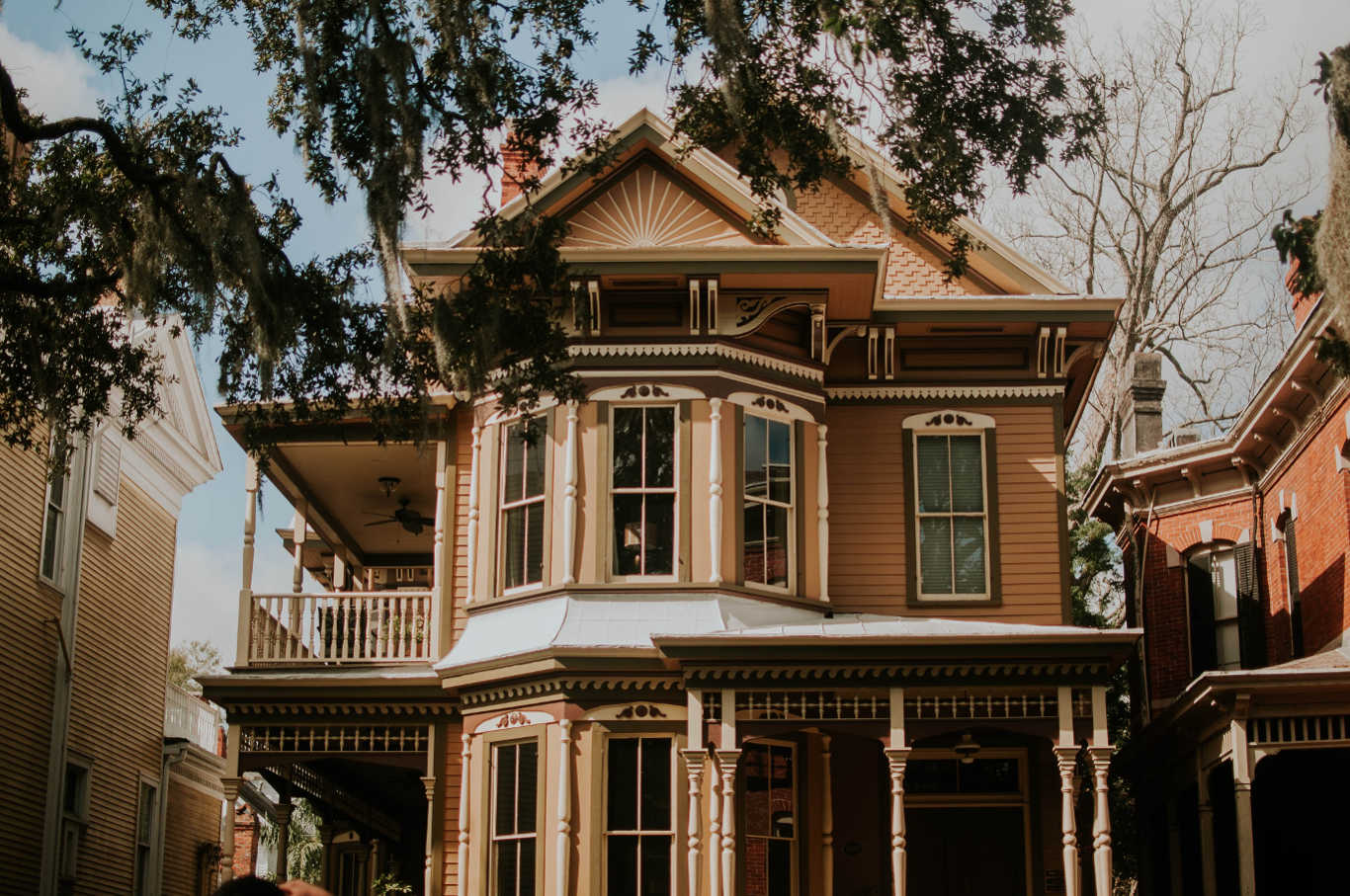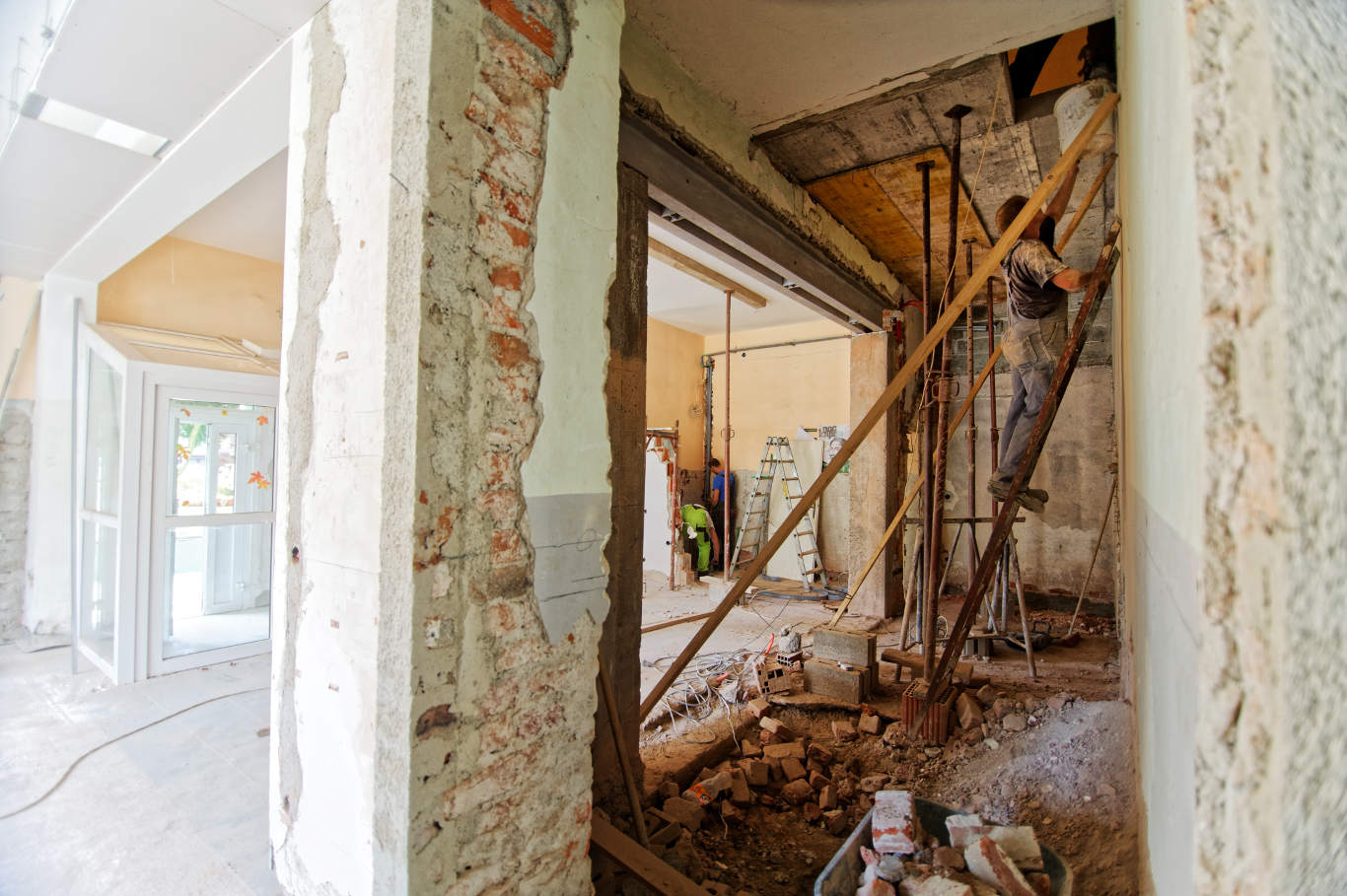There are a lot of reasons to love old homes. They’re solidly built, have tons of character, and often come with their own intriguing history. But old houses also have some risks, from outdated or unsafe materials, to structural problems.
Here’s what to look for when buying an old home.

Look Out for Lead Paint When Buying an Old Home
Lead used to be a major ingredient in paint. According to the Government of Canada, lead was once valued for its ability to decrease drying time, improve durability and make colors more vibrant in paints. In fact, in the 1940s, some paint had as much as 50% lead, measured by dry weight.
Over the following decades, a combination of new laws and self-regulation gradually decreased the amount of lead in paint. In 1976, the government restricted the amount to 0.5 per cent and in 2009, Surface Coating Materials Regulations reduced the total allowable lead to 0.009 per cent (with a few exceptions that shouldn’t impact most homeowners).
However, if you’re buying an older home, there’s a good chance that lead paint was used in it. Homes built before 1960 are most likely to contain lead paint. Even relatively new houses built between 1960 and 1990 often contain lead on the exterior and (generally in lower amounts) on the interior.

|
Home Insurance Quotes.
Home Insurance Rates From Canada's Top Insurance Companies.
Average savings $500. Coverage available from $1,000,000 to 2,000,000.
|
How to Identify Lead Paint
You can’t identify lead paint by looking at it, but it is possible to test for lead content. Home lead testing kits are available, which use a swab to identify if lead is available without disturbing the paint. One problem with this technique, however, is that it only tests the outer surface of the paint. If there is lead buried beneath multiple layers, a home testing kit won’t find it.
Paint chip analysis is more accurate. If you can obtain a chip of the paint, send it to a lab certified by either the Standards Council of Canada or the Canadian Association for Environmental Analytical Laboratories. Depending on where you live, you may also have the option of hiring a contractor to inspect for lead paint using x-ray fluorescence or another technique.
Why is Lead Paint a Problem? What Should You Do If You Find Lead Paint?
Lead is a toxic material, which can cause a wide range of health effects, from abdominal pains, to memory loss, to developmental problems. Lead is especially dangerous to infants, children and pregnant women, because even minute amounts can lead to serious health consequences like hearing loss, low birth rate and learning disabilities. Lead paint can also contaminate the surrounding environment via lead dust in the air and carpets, or paint chips in the soil.
However, just because you suspect lead paint doesn’t necessarily mean you should avoid the house. A solid, undamaged layer of lead paint in a room that children don’t have access to isn’t a health hazard, for example. The danger occurs when the lead paint begins to chip or flake, where the pieces can be chewed by young children.
It’s safe to contain undisturbed lead paint. You can do this by encapsulation — e.g. by putting up a layer of vinyl wallpaper or panelling. Another option is applying several layers of paint on top of it.
If you choose to remove the paint, DO NOT SAND IT. The dust created is more dangerous than just leaving the paint in place (although there are some dust-collecting sanders and media blasters that are safe).
Instead, use application strippers — chemical strippers applied with a brush — or another method that doesn’t create dust. If you do decide to remove paint yourself, read all safety instructions carefully. Paint strippers can be toxic, so be sure to use adequate ventilation and any other recommended safety measures. Alternatively, just hire a professional to do it for you.


|
Home Insurance Quotes.
Home Insurance Rates From Canada's Top Insurance Companies.
Average savings $500. Coverage available from $1,000,000 to 2,000,000.
|
Asbestos is a Common Danger in Older Homes
When you’re buying an older home, it’s important to keep an eye out for asbestos. Because of how useful (and cheap) it was — along with its properties as a fire retardant and insulator — it was used widely in older homes.
Unfortunately, it’s also dangerous. Asbestos fibres irritate the lung tissue, creating risk of mesothelioma — an extremely lethal form of cancer — and other serious lung diseases.
Asbestos is common in homes built before 1975. It was often used to insulate basement boiler pipes, but according to This Old House, it can also be found in a variety of other materials, including attic insulation, siding, both linoleum and vinyl tiles, and plaster.
How to Know if an Old Home has Asbestos
The short answer is, you can’t. There are certain kinds of asbestos like loose fill insulation (a white or blue-grey powder, used as thermal insulation) which are easy to recognize, but in most cases, you won’t know for sure just by looking.
In some cases, you can use the appearance and age of a material to predict that it might have asbestos, but the only way to know for sure is by testing.
Asbestos-containing materials might be painted over, covered by panelling, or hidden behind a wall or beneath the floor.
What to Do If You Suspect Asbestos
Asbestos is like lead paint, in that it isn’t dangerous unless disturbed. Frayed or powdered insulation, degraded ceiling tiles and other damaged materials can release asbestos fibres into the air, but when it is intact, it shouldn’t pose a problem. So, if the home is in good condition, the risk of asbestos shouldn’t necessarily stop you from purchasing.
However, asbestos does pose a serious risk for renovation — particularly because workers and DIYers are often unaware that it’s present. According to the Canadian Centre for Occupational Health and Safety (CCOHS), you can inadvertently release asbestos fibres in a wide range of home maintenance and improvement activities, from sanding plaster to removing hot water insulation.
If you are planning to renovate or make additions, it’s a good idea to have the house inspected for asbestos before you do. A professional will be able to spot materials that may contain asbestos, and have them tested. If they do find asbestos, you may need to have a professional contractor remove or encapsulate it, which can be somewhat costly. If you plan to make extensive changes, it may be worth calling in an inspector before you close.

|
Home Insurance Quotes.
Home Insurance Rates From Canada's Top Insurance Companies.
Average savings $500. Coverage available from $1,000,000 to 2,000,000.
|
Termites Are a Major Risk for Ontario Homeowners
Termites can be a serious problem when you’re purchasing an older home. There are more than 30 areas known to be inhabited by subterranean termites in Southern Ontario, causing substantial damages. In Toronto alone, termites cause over $120 million in damages annually. Colonies can spread quickly from infested wood to other homes in the neighborhood, causing potentially serious damage to the home.
For residents of the Western Coast in particular, the presence of dampwood termites (a different species than the subterranean termites which typically cause Ontario infestations) often indicates the presence of rot caused by excessive moisture.
The problem with termites is that they can cause extensive structural damage before they’re found. Termites eat wood from the inside out, and can tunnel inside walls, floors, window frames and other wooden materials until the weakened structure collapses. They can also damage other materials like drywall and sheetrock.
How to Check for Termites
Because they’re operating below the surface, termites are easy to miss, however, there are signs. When you’re considering buying an old home, look for:
- Mud tubes: At the name suggests, subterranean termites live underground. When aboveground, their bodies can dry out quickly, causing death. To protect themselves, they create “mud tubes” inside of wood using their own feces. According to the Entomological Society of Canada, mud tubes look “as if someone has painted long thin lines on your home with dirt.”
- Hollow walls: As termites tunnel through wood, they gradually change its acoustic properties. Knock on the walls and other wooden surfaces when you’re touring the house — particularly in ground floor rooms, basements and garages, where termites are more likely to be found. If a wall sounds hollow, it may be riddled with termite tunnels.
- Warped or discolored wood: Although warped or discolored wood is never a good sign in an old house, in the case of termites it can indicate a serious infestation. Look for dark spots or lines, flakes of paint or plaster, or unusual warps, bulges or bubbles beneath the paint.
- Environmental signs: Although the landscape can’t tell you for sure whether the house has termites, it can show signs of poor maintenance that create a risk. Wet, rotting wood around the property, or wood piles stacked close to or against the house can attract termites to the home. If there is scrap wood or firewood about, turn it over and look for tunnels.
Keep in mind that signs of possible termite presence outside the house doesn’t mean that there are termites inside. Termites and other insects play an important ecological role in the environment by breaking down old wood, and are an unavoidable fact of life in Ontario. However, if you do see infested wood near to an old house, you should be extra vigilant in checking that home for signs of termites. - Other signs: If you see swarms of what look like flying ants, you may actually be looking at swarmers — fertile termites that are sent out to start new colonies. You’re most likely to see them near light sources in the spring, but swarmers may also emerge in the autumn. Swarmers or piles of shed wings inside the house are very bad signs. You can also take a closer look by inspecting crawl spaces, and probing suspect wood with a knife or screwdriver.
Even if you know the signs, it’s a good idea to have the old home inspected for termites before closing, along with a general inspection. A termite inspector will be able to spot signs you could miss (and go into crawl spaces you may not want to explore). Many pest inspectors guarantee their services for a year, which protects you should you find a termite infestation they missed.
Most Old Houses Need Electrical Work
Old electrical wiring can be an inconvenience. Older homes are not designed for the power requirements of modern appliances, which can lead to outages and frequent blown fuses.
However, as annoying as inadequate wiring can be, there could be a much more serious issue lurking: the risk of electrical fires. While the wires themselves can last for a century or more, pre 1930s wiring insulation only has a lifespan of around 70 years. And that is assuming the wiring has been properly installed. Improper installation, unusually high temperatures and other issues can cause the wiring insulation to fail prematurely.
Fuse boxes and circuit breakers are another risk. Homeowners with old wiring may get tired of blowing fuses, and decide to install fuses rated for higher current, or modern circuit breakers to solve the problem. If they do this without replacing the wiring (or replace the wiring with wires that aren’t rated for the higher current), this can increase the temperature of the wiring, and the wear on the insulation.

|
Home Insurance Quotes.
Home Insurance Rates From Canada's Top Insurance Companies.
Average savings $500. Coverage available from $1,000,000 to 2,000,000.
|
Why is Old Wiring a Problem?
Old wiring can cause house fires. Wires depend on insulation to separate the live current from the ground. As the insulation wears away, it can create sparks, which can light insulation or other materials. Non-functioning fuse boxes, or fuses that allow more current than the wire is designed for increase the risk. More current means more heat, which can lead to a fire behind the wall.
There are other dangers as well. Old houses may not have ground fault circuit interrupters (GFCI), which prevent electrocution in sinks, bathrooms and other areas where water is near electricity. Even if there are GFCIs, they may be outdated or non-functioning.
Another electrical issue is over-lamping. Modern bulbs may use more energy, and thus produce more heat than a light fixture is designed for, increasing the risk of fire. This is less of a problem with the introduction of low power LED and compact fluorescent lamp (CFL) bulbs, but those can pose their own problems. For example, using CFLs that aren’t designed for dimmers in dimmer sockets can lead to current surges and the risk of fire.
You should also be on the lookout for lights flickering when the wind blows. This can indicate that the wiring from the powerline to the house (called the weatherhead) is frayed, creating a fire risk.
What to Do About Old Wiring
When it comes to electricity, you really don’t want to take risks. Have it professionally inspected, and if necessary, replaced. If you aren’t able to fix the wiring before you move in, be very cautious about your use of appliances.
Avoid using hair dryers, plug-in heaters, microwaves and other appliances that use a lot of power as much as possible. When you do use appliances, try to position them so that they’re not all on the same circuit. You may wish to avoid using installed lighting as well, until you can have it evaluated.
Thorough Inspections Eliminate Nasty Surprises
Although old houses are prone to certain types of problems, any house could be hiding dangerous or unhealthy secrets. Working with inspectors you trust and bringing in other experts as needed may cost a little more up front, but unknowingly stumbling into a fire trap or a termite infestation is much costlier. When it comes to your investment and the safety of your family, you can’t be too careful.

|
Home Insurance Quotes.
Home Insurance Rates From Canada's Top Insurance Companies.
Average savings $500. Coverage available from $1,000,000 to 2,000,000.
|
